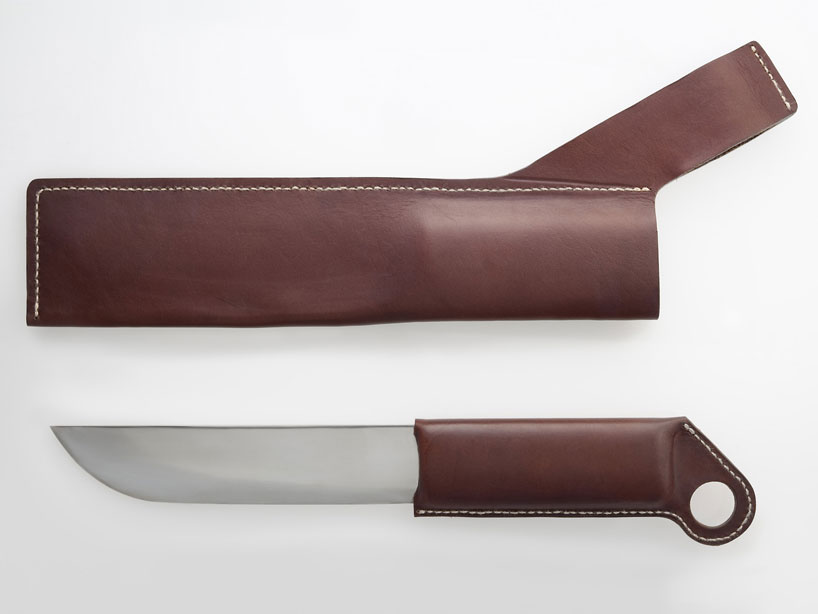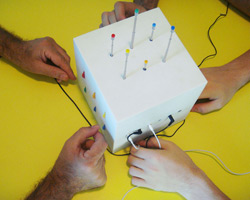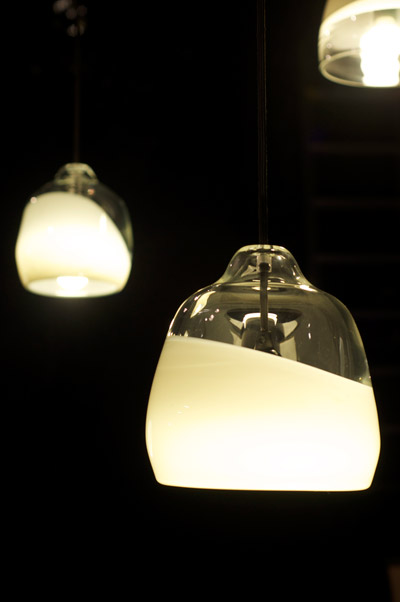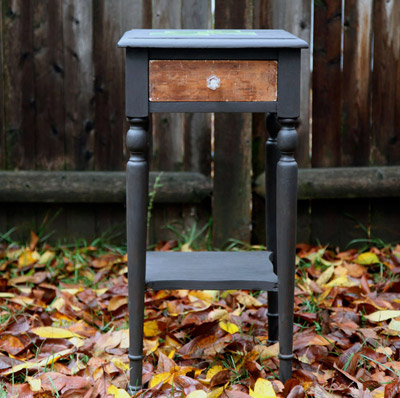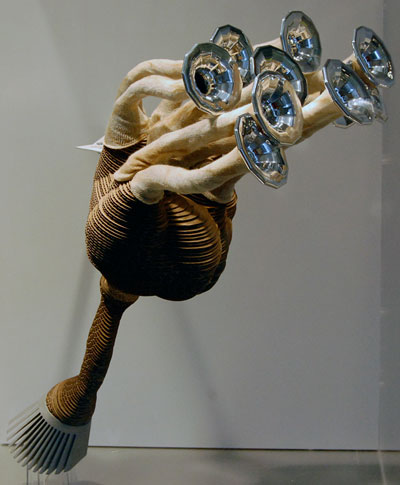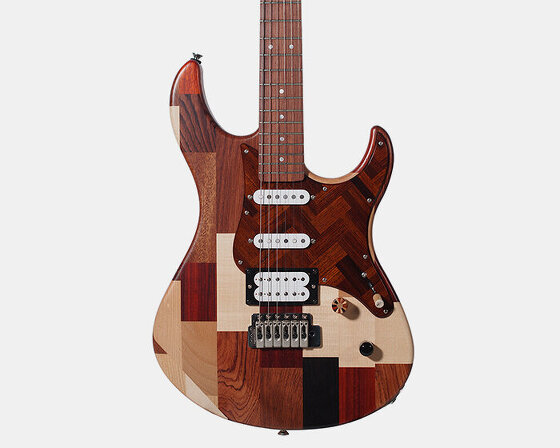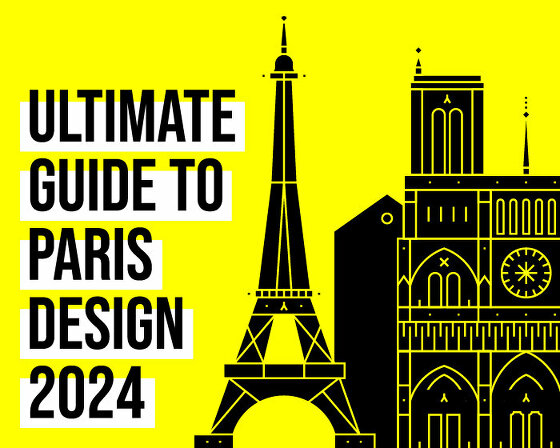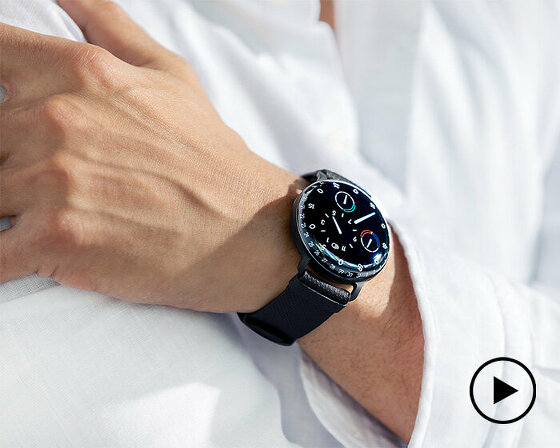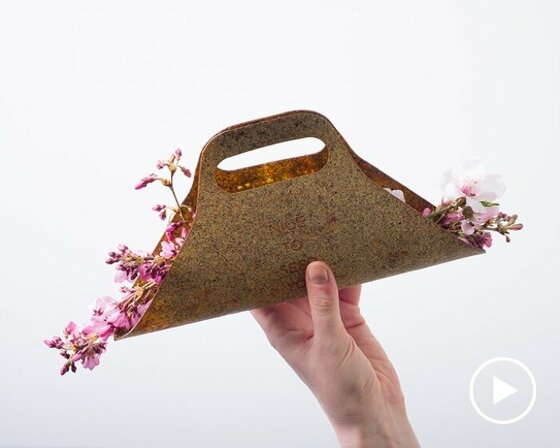konstantin grcic (munich, germany) steel, leather prototype maker: pekka tuominen
the purpose of the ‘sámi knife II’ exhibition, presented at the saint-étienne biennale 2010, was to bring attention to the current situation and future of the ‘leuku’ sámi knife, an important tool used daily by the sámi people in lapland.
the ‘leuku’ is a traditional type of long sámi sheath knife with 300 years of historical development. it is used in reindeer husbandry and trips through the lapland wilderness. the sámi leuku, known in the sámi language is known as ‘stuorniibi’ or ‘sámeniibi’.
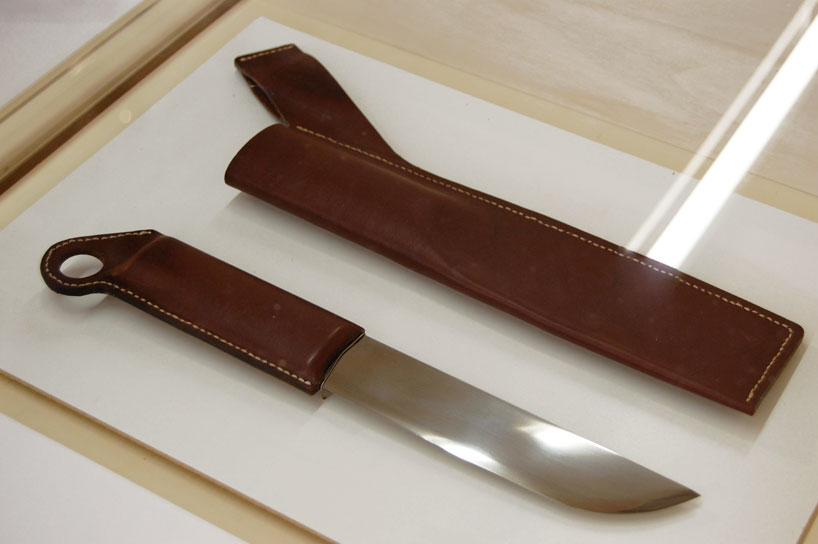 konstantin grcic’s sámi knife design with leather handle and case image © designboom
konstantin grcic’s sámi knife design with leather handle and case image © designboom
curated by simo heikkilä, this exhibition was a presentation of these leuku knives reinterpreted. traditionally made by the sámi people, the aim of the show was to arouse debate about how many locally developed tools and utensils are disappearing as a result of more competitive prices induced by mass production. on this occasion heikkilä invited renowned designers including konstantin grcic, ronan and erwan bouroullec, naoto fukasawa, jasper morrison, gijs bakker etc., to redesign this knife, asking them to give it a new and contemporary existence. this revival project highlights the importance of the handcrafted tradition as the basis for a tool culture, and also seeks new life for the sámi knife by studying the potential for further development in terms of both its design and methods of using it.
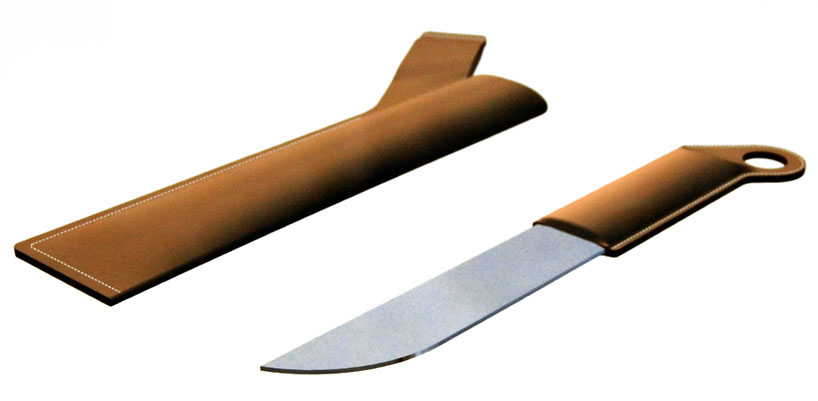 rendering of konstantin grcic’s design photo by designboom
rendering of konstantin grcic’s design photo by designboom
the oldest known finnish puukko knife is from the town of kaarina and dates back to 700 BC. it is of a type known as a vökipuuko with a long, narrow blade and was probably used as a sign of power as well as for self-defense. visapöä is an old name for a hilt made of curly-grained birch (visokoivu). visokoivu is unhealthy birch which mainly grows in lapland. it is extremely hard and has a beautiful curly grain. findland’s oldest puukko with a visapöä hilt was found in turku and dates from around 1300 AD.
 technical diagram of grcic’s design photo by designboom
technical diagram of grcic’s design photo by designboom
the oldest copper puukko from the sámi areas were found in nesseby in the varanki (varanger) area and is believed to be about 4, 000 years old. because metal-working skills were still unknown in this area, it is assumed to be the result of barter on the russian trade route. the so-called ‘inari-puuko’ dates from the time of the crusades, around 1000 AD. it was carried crosswise on a belt and is decorated with metal crosses. carrying a puukko crosswise was common throughout the baltic area and in sweden and the custom survived for a long time among the finno-urgic peoples in siberia.
 naoto fukasawa (tokyo, japan) steel, stainless steel, birch, leather prototype maker: pasi jaakonaho
naoto fukasawa (tokyo, japan) steel, stainless steel, birch, leather prototype maker: pasi jaakonaho
the development of the puukko and the leuku into their present form has been a long process. bronze was made by mixing it with copper, but it was not until people learned to use the iron ore found in bogs and on lake beds that strong iron tools could be made. the oldest furnaces for smelting lake-bed ore, which date from about 200-300 AD, have been found in northeast scandinavia. the puukko’s period of ascendancy in the nordic countries did not, however, begin until the swedes learned how to use rocky ore from the mountains. knowledge about tempting steel with oil did not come to finland until the mid nineteenth century when thomas woodward, an englishman, came to work at the fishers’ knife works.
 sámi knife design by naoto fukasawa image © designboom
sámi knife design by naoto fukasawa image © designboom
separate puukko cultures developed in northern and southern finland in parallel. lad tempering techniques were learned from the south, but the horn reinforcement of the sámi sheath and the shape of its curve influenced the development of the sheath in southern finland. the fenno-ugric peoples living in the sámi areas in varanki were known for the excellent puukkos they made. actual smiths were unknown in the sámi regions until the late nineteenth century, so puukkos were made at home for the maker’s own needs, just like any other tool. the necessary skills were handed down from father to son. eventually the basic leuku became standardized throughout lapland.
 naoto fukasawa’s knife sketch photo by designboom
naoto fukasawa’s knife sketch photo by designboom
 louise campbell (copenhagen, denmark) painted original josef laiti’s leuku, reindeer skin prototype maker: josef laiti, samuel valkeapää image © designboom
louise campbell (copenhagen, denmark) painted original josef laiti’s leuku, reindeer skin prototype maker: josef laiti, samuel valkeapää image © designboom
danish designer louise campbell on her contribution to the project: ‘I do not see any reason to re-design the knife. it is perfect as it is. big, sharp, durable, and beautifully crafted from local materials. it serves its purpose perfectly. but I do see great reason to honour the sámi knife. for what it is, for how it is made, and for what it can do.
I therefore kindly ask you to do to the following: produce a knife exactly as you would usually do. from basic materials, and completely without ornament. then cover the entire knife with a thick layer of pure white glossy paint, only leaving the sharpened side of the blade free. the same goes for the sheath. for this, kindly use the palest leather found locally, and leave it untreated. again, no ornament, just function. the white knife is an attempt to focus on the core point of this sublime produce: its purity and its purpose. the sámi knife is made for use, not to be a showpiece. it is, when in use, covered with blood, dirt, wood stains, fat, grease, and becomes more beautiful the more it is used.
the white knife will wear fast, until finally all the white has worn off. in honour of a fine tradition from far up north, where snow still stays on the ground in the winter months, and where people still produce the finest craftsmanship.‘
 louise campbell’s sámi sketch photo by designboom
louise campbell’s sámi sketch photo by designboom
 shigeru uchida (tokyo, japan) steel, stainless steel, wood, colored silk string prototype makers: studio 80, japan image © designboom
shigeru uchida (tokyo, japan) steel, stainless steel, wood, colored silk string prototype makers: studio 80, japan image © designboom
japanese designer shigeru uchida’s knife features a handle and case which have been wrapped with a colored silk string.
 detail of shigeru uchida’s knife design image © designboom
detail of shigeru uchida’s knife design image © designboom
 shigeru uchida’s knifesketch photo by designboom
shigeru uchida’s knifesketch photo by designboom
 jasper morrison (london, UK) steel, stainless steel, nylon, leather prototype makers: janne hirvonen, arja lehtimäki image © designboom
jasper morrison (london, UK) steel, stainless steel, nylon, leather prototype makers: janne hirvonen, arja lehtimäki image © designboom
 sámi knife design by jasper morrison image © designboom
sámi knife design by jasper morrison image © designboom technical drawing of jasper morrison’s sámi knife photo taken by designboom
technical drawing of jasper morrison’s sámi knife photo taken by designboom
 gijs bakker (amsterdam, the netherlands) steel, brass, reindeer horn, leather prototype makers: martin hackenberg, petteri kyrö image © designboom
gijs bakker (amsterdam, the netherlands) steel, brass, reindeer horn, leather prototype makers: martin hackenberg, petteri kyrö image © designboom
 sketches by gijs bakker photo by designboom
sketches by gijs bakker photo by designboom
 sketches by gijs bakker photo by designboom
sketches by gijs bakker photo by designboom
 erwan and ronan bouroullec (paris, france) steel, reindeer horn prototype makers: aimo pitkä, pasi jaakonaho / SAKK image © designboom
erwan and ronan bouroullec (paris, france) steel, reindeer horn prototype makers: aimo pitkä, pasi jaakonaho / SAKK image © designboom
 models of erwan and ronan bouroullec’s knife design image © designboom
models of erwan and ronan bouroullec’s knife design image © designboom
 sketch by erwan and ronan bouroullec photo by designboom
sketch by erwan and ronan bouroullec photo by designboom
 alfredo häberli (zurich, switzerland) stainless steel, silver, sallow prototype makers: tomosi nakano, ari pykäläaho image © designboom
alfredo häberli (zurich, switzerland) stainless steel, silver, sallow prototype makers: tomosi nakano, ari pykäläaho image © designboom
the concept behind alfredo häberli’s knife redesign is to pass on precious traditions, stories and personal history from generation to generation. the leuku is an everyday object that takes part in the owner’s actions. that is how it becomes a souvenir of his adventures and experiences. the handwriting on the blade shows the signification as a storyteller would write in a diary. the wooden handle and sheath form one unitary shape.
 photos of inspiration of alfredo häberli photo by designboom
photos of inspiration of alfredo häberli photo by designboom
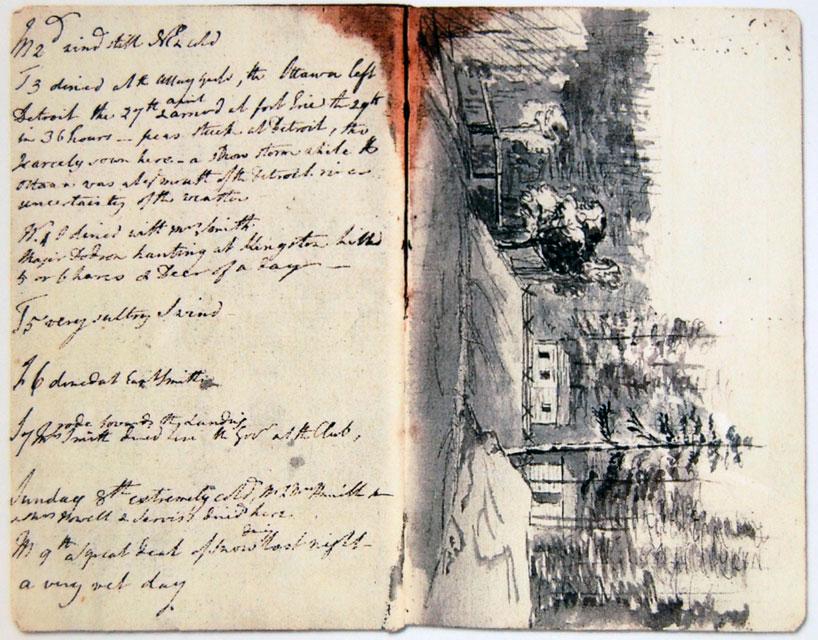 alfredo häberli referenced diaries such as elizabeth simcoe’s (pages 6-7) shown here courtesy of the archives of the government of canada
alfredo häberli referenced diaries such as elizabeth simcoe’s (pages 6-7) shown here courtesy of the archives of the government of canada
 petteri laiti (inari, lapland) steel, reindeer horn, curly birch, sallow root, silver, reindeer ear leather prototype maker: petteri laiti image © designboom
petteri laiti (inari, lapland) steel, reindeer horn, curly birch, sallow root, silver, reindeer ear leather prototype maker: petteri laiti image © designboom
 sámi knife sketch by petteri laiti image © designboom
sámi knife sketch by petteri laiti image © designboom
saint etienne biennale 2010 (11)
PRODUCT LIBRARY
a diverse digital database that acts as a valuable guide in gaining insight and information about a product directly from the manufacturer, and serves as a rich reference point in developing a project or scheme.
